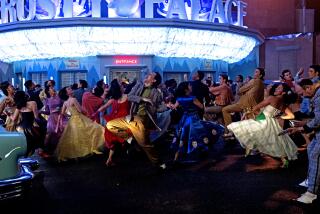Dance-Video Choreographer Packs a Punch With ‘Swine’
- Share via
Sarah Elgart is ready for a fight. This gamin with high, Vogue-model cheekbones and an explosive spirit is sitting in a cafe in West Hollywood next door to EZTV, where she has just previewed her “Pearls Before Swine,” a part-lyrical, part-MTV-style dance video made last spring at Robert Redford’s Sundance Institute in Utah.
It will be shown on two 22-inch monitors Friday at El Camino College as part of the Sarah Elgart and Company program that also includes two live dance works: “Loveletters” and the premiere of “Maybe He Go.”
Asked if her stage work has changed since her career blossomed as a dance-video choreographer, Elgart responds angrily that her stage work has “only been enriched by being behind a camera.” To date, she’s made 35 pop videos and choreographed for eight feature films, including “Howard the Duck” and the forthcoming “Earth Girls Are Easy.”
She says her eight-minute “Pearls Before Swine” video “synthesizes” her “choreographic concerns” and her knowledge of film work to make “a new form.”
But this gestural drama about a woman who wakes up beside a sleeping man, stretches, washes, applies makeup and experiences a breakdown includes little dancing of any sort. It’s Chaplinesque in its ability to paint psychological portraits via mime and gesture. But frequent cuts keep the movement from developing into a dance.
Elgart, who gives her age as 32, bristles at questions about the subordination of pure-dance expression to narrative in her work.
“I don’t devalue the power of pure-dance expression,” she says, fuming. “I’m just not interested in it.
“I’m in a position to say that I am changing the way my dances are seen,” Elgart declares, proclaiming her philosophy of dance as gestural expression and not as an abstract or even virtuosic art.
“I’m interested in the human condition, not 32 fouette turns,” she explains. “For me, (choreography) has to do with treating gesture in so special a way that it’s like a language and may no longer look like pure movement, but more like real life.
“There’s always torment in my life,” she adds, “and the confrontation of mortality in the video is very much my own coming to terms with death and demons in dramatic terms.
“I’ve always taken my life experiences and tried to transform them into art.”
Elgart says that her new concern is to create dance for film, “where dance carries equal weight in a dramatic situation, a film in which the dramatic situation sheds as much light on the dance as the dance does on the dramatic situation.
“With Fellini you had the sense that the line between walking and dancing was very thin,” she says. “You’d have your story and there would be an old lady crouching and a little girl imitating--all ways of enriching characters in a way Hollywood seems scared to (do) because it seems uneasy with dance unless it’s used in recital form as in ‘Dirty Dancing’ or ‘The Turning Point.’ ”
If Elgart is so obsessed with pedestrian gesture over pure movement, why doesn’t she pursue a career in independent, dance-based film making--or performance art? Why call herself a choreographer?
“Look, you’re the one making the definitions and the limitations, not me,” she responds, adding that she intends to adapt “Recess” into a 30-minute film. She has also “considered” thinking of herself as a performance artist during those times when she has been most influenced by Pina Bausch’s and Rachel Rosenthal’s expressions in that form.
“But I’ve always begun my work with bodies and their presence in the studio,” she says. “Even with all the movie offers in the world, I don’t foresee that changing.
“What film work has done is convince me of what I want to leave out on the stage,” Elgart explains. “It provides enough income so that I don’t have to work when I make a dance piece. And I’ve grown as an artist.
“A performance artist opens a field of reference to include literature, art, history and dance,” she says. “I’m opening mine to include film. I don’t presume to call what I do art at any given moment. Maybe it’s an experiment, or a work in progress.
“The idea is to test your limits and not live by other people’s expectations--no matter how hard they ridicule you.”
More to Read
The biggest entertainment stories
Get our big stories about Hollywood, film, television, music, arts, culture and more right in your inbox as soon as they publish.
You may occasionally receive promotional content from the Los Angeles Times.










